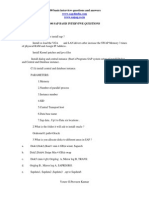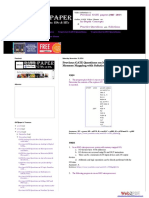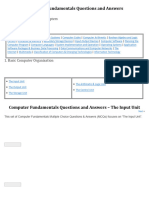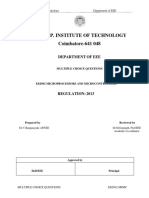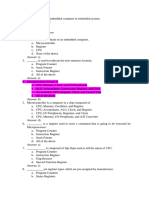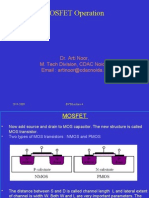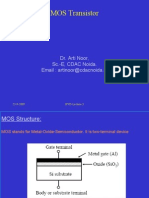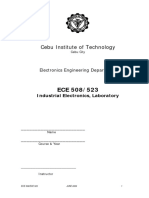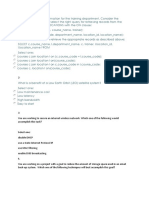JUNE 2014: Code: AE68 Subject: Embedded Systems Design
JUNE 2014: Code: AE68 Subject: Embedded Systems Design
Uploaded by
Abhishek SinghCopyright:
Available Formats
JUNE 2014: Code: AE68 Subject: Embedded Systems Design
JUNE 2014: Code: AE68 Subject: Embedded Systems Design
Uploaded by
Abhishek SinghOriginal Description:
Original Title
Copyright
Available Formats
Share this document
Did you find this document useful?
Is this content inappropriate?
Copyright:
Available Formats
JUNE 2014: Code: AE68 Subject: Embedded Systems Design
JUNE 2014: Code: AE68 Subject: Embedded Systems Design
Uploaded by
Abhishek SinghCopyright:
Available Formats
ROLL NO.
_________________
Code: AE68
Subject: EMBEDDED SYSTEMS DESIGN
AMIETE ET
Time: 3 Hours
JUNE 2014
Max. Marks: 100
PLEASE WRITE YOUR ROLL NO. AT THE SPACE PROVIDED ON EACH PAGE
IMMEDIATELY AFTER RECEIVING THE QUESTION PAPER.
NOTE: There are 9 Questions in all.
Question 1 is compulsory and carries 20 marks. Answer to Q.1 must be written in
the space provided for it in the answer book supplied and nowhere else.
The answer sheet for the Q.1 will be collected by the invigilator after 45 minutes of
the commencement of the examination.
Out of the remaining EIGHT Questions answer any FIVE Questions. Each
question carries 16 marks.
Any required data not explicitly given, may be suitably assumed and stated.
Q.1
Choose the correct or the best alternative in the following:
(2 10)
a. Embedded system is
(A) Singled functioned
(C) Delay system
(B) Multi functioned
(D) Non-reactive
b. Which of the following is parallel protocol
(B) I2C
(D) Bluetooth
(A) ARM Bus
(C) USB
c. CAN stands for
(A) Common Architecture Network (B) Cascade Architecture Network
(C) Cascade Area Network
(D) Controller Area Network
d. Moore's Law predicts that transistor density would double in every
(A) 5 to 6 months
(C) 12 to 20 months
(B) 18 to 24 months
(D) 24-28 months
e. A program that runs on one processor but executes instructions of another
processor is called
(A) Emulator
(C) Compiler
(B) Instruction-set Simulator
(D) Debugger
f. Instruction throughput of microprocessor can be increased by
(A) Instruction Fetch
(C) Debugging
AE68 / JUNE 2014
(B) Instruction Decode
(D) Pipelining
AMIETE ET
ROLL NO. _________________
Code: AE68
Subject: EMBEDDED SYSTEMS DESIGN
g. Which of the following statement is true?
(A) General purpose processor can be mapped to PLD IC technology only
(B) General purpose processor can be mapped to Semi-custom IC technology
only
(C) Single purpose processor can be mapped to PLD IC technology only
(D) Any processor technology can be mapped to any IC technology
h. One time monetary cost of designing the system is called
(A) Unit cost
(C) Total cost
(B) NRE cost
(D) Manufacturing cost
i. In RTOS, function that works properly even if it is called by more than one task
is called
(A) Scheduler
(C) Re-entrant Function
(B) Pre-emptive function
(D) Non-preemptive Function
j. The timer used by RTOS to maintain timing services is
(A) Heartbeat Timer
(C) Reactive Timer
(B) Watchdog Timer
(D) System Clock
Answer any FIVE Questions out of EIGHT Questions.
Each question carries 16 marks.
Q.2
a. What are the commonly used design matrices for Embedded System Design?
Describe various techniques that can be used to map gate-level implementation
onto an IC.
(8)
b. Differentiate between FSM and FSMD. Draw and describe controller and
datapath to implement Greatest Common Divisor of two numbers.
(8)
Q.3
Q.4
a. Describe the various design tools used to design, test and debug embedded
software.
(8)
b. What are ASIPs? Describe three major varieties of ASIPs used.
(8)
a. Describe stepper motors and their use in Embedded Systems.
(8)
b. Differentiate between Timer and counters and describe the use of Watchdog
Timer to implement timeout in Automatic Teller Machine.
(8)
Q.5
a. Compare SRAM and DRAM. Draw and explain the internal structure of RAM.
(8)
b. Describe Memory hierarchy and cache-mapping techniques.
Q.6
(8)
a. Describe various methods of Arbitration in case multiple peripherals request
service from single source.
(8)
AE68 / JUNE 2014
AMIETE ET
ROLL NO. _________________
Code: AE68
Subject: EMBEDDED SYSTEMS DESIGN
b. Explain the difference between port based I/O and bus based I/O also discuss
advantages and disadvantages of Memory mapped I/O Vs Standard I/O.
(8)
Q.7
a. What is a task in RTOS? Describe various task states also explain Scheduler in
RTOS.
(8)
b. Describe Preemptive and non-preemptive Kernels. Also discuss techniques to
protect shared data in RTOS.
(8)
Q.8
a. Explain Event in reference to RTOS and describe the standard features of
event. Compare events and Semaphores.
(8)
b. Discuss priority in interrupts and describe in detail with examples rules
followed by Interrupt Routines in RTOS.
(8)
Q.9
a. Describe hard and soft real time systems. Give suitable examples. Discuss
various power saving techniques in Embedded Systems.
(8)
b. Discuss encapsulation of semaphores and queues.
AE68 / JUNE 2014
(8)
AMIETE ET
You might also like
- Computer Fundamentals Questions and AnswersDocument276 pagesComputer Fundamentals Questions and AnswersMersal Ahmed AnamNo ratings yet
- MQ Series For AS400Document84 pagesMQ Series For AS400Ramana VaralaNo ratings yet
- Service Manual Dell 3100cnDocument90 pagesService Manual Dell 3100cnfaco1723No ratings yet
- 100 Sap Basis Interviwe QuestionsDocument10 pages100 Sap Basis Interviwe Questionsapi-3766700100% (5)
- AE68Document4 pagesAE68MahadevNo ratings yet
- Ae68 4Document3 pagesAe68 4MahadevNo ratings yet
- OCTOBER 2012: Amiete - Cs/It (Old Scheme)Document3 pagesOCTOBER 2012: Amiete - Cs/It (Old Scheme)Navaneeth NairNo ratings yet
- AMIETE - ET (Current & New Scheme) : Code: Ae68/Ae117 Subject: Embedded Systems DesignDocument3 pagesAMIETE - ET (Current & New Scheme) : Code: Ae68/Ae117 Subject: Embedded Systems DesignsahadevNo ratings yet
- Ae68 Ae117 J16Document3 pagesAe68 Ae117 J16navyaindynavyaindyNo ratings yet
- Embedded SystemDocument2 pagesEmbedded Systemsahayajeicy10No ratings yet
- Dec 13 001Document3 pagesDec 13 001Deepak SharmaNo ratings yet
- C2 MCQDocument34 pagesC2 MCQBUQRA AN FARDEENA BINTI MOHAMED FAIRUZ STUDENTNo ratings yet
- Btech Ee 604d Embedded Systems 2013Document4 pagesBtech Ee 604d Embedded Systems 2013gsh9565No ratings yet
- Objective QA - EC 6009Document13 pagesObjective QA - EC 6009Santhanamari GNo ratings yet
- 64/ACV/O Set - : Day and Date of ExaminationDocument4 pages64/ACV/O Set - : Day and Date of ExaminationJames CathivkNo ratings yet
- Mces MCQDocument50 pagesMces MCQshrimanNo ratings yet
- Btech Ee 6 Sem Embedded Systems 2013Document4 pagesBtech Ee 6 Sem Embedded Systems 2013gsh9565No ratings yet
- Embedded Systems Model Question PaperDocument6 pagesEmbedded Systems Model Question PaperSubramanyaAIyerNo ratings yet
- WWW Gatepaper inDocument16 pagesWWW Gatepaper inSrihari UttanurNo ratings yet
- 05 Computer FundementalsDocument213 pages05 Computer FundementalsHaseebullah MoasaqNo ratings yet
- This Set of Computer Fundamentals Multiple Choice Questions & Answers (MCQS) Focuses On "The Input Unit"Document44 pagesThis Set of Computer Fundamentals Multiple Choice Questions & Answers (MCQS) Focuses On "The Input Unit"Virtual BrainsNo ratings yet
- Model Question Papers. Pgdca 101 Computer Organization and Operating SystemsDocument6 pagesModel Question Papers. Pgdca 101 Computer Organization and Operating SystemsSuraj GiriNo ratings yet
- Set No. 1Document7 pagesSet No. 1Dinesh Padma Rao KadiyamNo ratings yet
- CSC 2118 EXAM JAN2023 FinalDocument15 pagesCSC 2118 EXAM JAN2023 FinalSebunya RonaldoNo ratings yet
- Thapar Institute of Engineering & Technology, Patiala: End Semester Examination (May 2019)Document4 pagesThapar Institute of Engineering & Technology, Patiala: End Semester Examination (May 2019)Forza HorizonNo ratings yet
- TCS1063_B_QP(Julai2020)Document5 pagesTCS1063_B_QP(Julai2020)asj233510377No ratings yet
- IES Objective Question BankDocument10 pagesIES Objective Question BankNischal ParsiNo ratings yet
- Lllit5: Embedded System DesignDocument4 pagesLllit5: Embedded System DesignAnonymous 2MwnnyNo ratings yet
- Es Model QPDocument13 pagesEs Model QPலோகேஷ் கிருஷ்ணமூர்த்திNo ratings yet
- Embedded System PaperDocument1 pageEmbedded System PapertwilightrenesmeeNo ratings yet
- OS ToughDocument7 pagesOS ToughReoNo ratings yet
- ES Final January8Document2 pagesES Final January8mohammed2290% (1)
- Namma Kalvi 11th Computer Applications Question Bank EM 220499Document41 pagesNamma Kalvi 11th Computer Applications Question Bank EM 220499Kanishka S IX-ENo ratings yet
- MCQ - MPMCDocument9 pagesMCQ - MPMCRanganayaki RamkumarNo ratings yet
- Assessment 1Document9 pagesAssessment 1Shivam SinghNo ratings yet
- Fundamentals of Microprocessor 8085: Multiple Choice QuestionsDocument21 pagesFundamentals of Microprocessor 8085: Multiple Choice Questionsraghavrocks89No ratings yet
- Computer OrganizationDocument8 pagesComputer OrganizationVeerabhadra Durgam100% (2)
- OPERATING SYSTEM GATE QUESTIONSDocument11 pagesOPERATING SYSTEM GATE QUESTIONSvimalvr.sseNo ratings yet
- Microprocessor: (1 Mark Each)Document14 pagesMicroprocessor: (1 Mark Each)SeekEducationNo ratings yet
- Important Questions From Module 3, 4 & 5: A Task Must Be Serviced by Its Deadline PeriodDocument4 pagesImportant Questions From Module 3, 4 & 5: A Task Must Be Serviced by Its Deadline Periodanupnaskar naskarNo ratings yet
- ISAZ Senior Computer Science-IT - Olympiads QuestionsDocument16 pagesISAZ Senior Computer Science-IT - Olympiads QuestionsChikondi KabukaNo ratings yet
- HW1 Spring2016Document3 pagesHW1 Spring2016rusdiNo ratings yet
- CIM QuestionsDocument24 pagesCIM QuestionsPraveen SundarNo ratings yet
- JUNE 2014: Amiete - Et/Cs/ItDocument3 pagesJUNE 2014: Amiete - Et/Cs/ItDipak NandeshwarNo ratings yet
- Embedded System QPDocument9 pagesEmbedded System QPnithyaNo ratings yet
- 5 Oct11Document12 pages5 Oct11Manu SeaNo ratings yet
- BCA-146-20, BCA-CS-146-20 Operating SystemDocument2 pagesBCA-146-20, BCA-CS-146-20 Operating SystemKamlesh MaliNo ratings yet
- Old Q.papers M.tech I SemDocument15 pagesOld Q.papers M.tech I SemallakagopichandNo ratings yet
- Embedded QuestionsDocument7 pagesEmbedded QuestionsAdem AbdelaNo ratings yet
- Chapter 1 Introduction To Computer Architecture: Multiple-ChoiceDocument17 pagesChapter 1 Introduction To Computer Architecture: Multiple-ChoiceAri BaderNo ratings yet
- Unique Academy: Secondary Part-I (9 Class) Examination Session 2013-2014Document2 pagesUnique Academy: Secondary Part-I (9 Class) Examination Session 2013-2014Muhammad KaleemNo ratings yet
- OS ExamDocument3 pagesOS ExamEnatCollege EthiopiaNo ratings yet
- J11 Question PaperDocument4 pagesJ11 Question PapersearchingubabyNo ratings yet
- Updated Arm ProcessorDocument10 pagesUpdated Arm Processornaacvins23No ratings yet
- BSC Itim May 2013BSC IT Prevoues Question PaperDocument28 pagesBSC Itim May 2013BSC IT Prevoues Question PaperPurushothama KilariNo ratings yet
- M.E. (VLSI & Embedded Systems) Analog & Digital Cmos Ic Design (2008 Course)Document4 pagesM.E. (VLSI & Embedded Systems) Analog & Digital Cmos Ic Design (2008 Course)Manu SeaNo ratings yet
- Cs8491 Computer Architecture Unit - 3Document9 pagesCs8491 Computer Architecture Unit - 3ASIF MNo ratings yet
- Computer Architecture Quiz-II SolutionDocument4 pagesComputer Architecture Quiz-II SolutionAkram MohammadNo ratings yet
- SP MCQDocument15 pagesSP MCQVishal KesharwaniNo ratings yet
- PLCDocument3 pagesPLCgowthaman rajNo ratings yet
- TVEC Model Paper Programmable Logic ControllerDocument2 pagesTVEC Model Paper Programmable Logic ControllerSajith MadushankaNo ratings yet
- CMPS Comprehensive Exam MCQ PRACTICE QuestionsDocument75 pagesCMPS Comprehensive Exam MCQ PRACTICE QuestionsKOTHURU MNo ratings yet
- C Programming for the Pc the Mac and the Arduino Microcontroller SystemFrom EverandC Programming for the Pc the Mac and the Arduino Microcontroller SystemNo ratings yet
- Gold Specification Witth Remlot 16.7.12-Sever LoadedDocument56 pagesGold Specification Witth Remlot 16.7.12-Sever LoadedAbhishek SinghNo ratings yet
- Design Notes: Lowćvoltage Differential Signaling (LVDS)Document7 pagesDesign Notes: Lowćvoltage Differential Signaling (LVDS)Abhishek SinghNo ratings yet
- Board 1v3Document1 pageBoard 1v3Abhishek SinghNo ratings yet
- lpc1763 lpc1764 lpc1765 lpc1766 lpc1767 lpc1768 lpc1769Document79 pageslpc1763 lpc1764 lpc1765 lpc1766 lpc1767 lpc1768 lpc1769Tiago Coelho PereiraNo ratings yet
- lpc1763 lpc1764 lpc1765 lpc1766 lpc1767 lpc1768 lpc1769Document79 pageslpc1763 lpc1764 lpc1765 lpc1766 lpc1767 lpc1768 lpc1769Tiago Coelho PereiraNo ratings yet
- Syl Ba3 MathsDocument4 pagesSyl Ba3 MathsAbhishek SinghNo ratings yet
- UC Mutual Exclusion SemaphoreDocument27 pagesUC Mutual Exclusion SemaphoreAbhishek SinghNo ratings yet
- Programs Aug - To Oct.Document2 pagesPrograms Aug - To Oct.Abhishek SinghNo ratings yet
- Mos CapacitancesDocument26 pagesMos CapacitancesAbhishek SinghNo ratings yet
- Lecture-7 Mos Spice Models: Dr. Arti Noor, M. Tech Division, CDAC Noida. Email: Artinoor@cdacnoida - inDocument22 pagesLecture-7 Mos Spice Models: Dr. Arti Noor, M. Tech Division, CDAC Noida. Email: Artinoor@cdacnoida - inAbhishek SinghNo ratings yet
- MOSFET OperationDocument26 pagesMOSFET OperationAbhishek Singh100% (1)
- MOS TransistorDocument21 pagesMOS TransistorAbhishek Singh100% (1)
- Embedded SyllabusDocument5 pagesEmbedded SyllabusAbhishek Singh100% (2)
- Z Source Inverter Thesis PDFDocument6 pagesZ Source Inverter Thesis PDFimmkhuwhd100% (3)
- Mimosa Radisys C5x Datasheet DS 2024 01Document4 pagesMimosa Radisys C5x Datasheet DS 2024 01sinisastevcic77No ratings yet
- Sce 020 100 Process Description Sorting Station Intro r1709 enDocument10 pagesSce 020 100 Process Description Sorting Station Intro r1709 enJoachimNo ratings yet
- Interface Module XC: Protocol Converter / User ManualDocument12 pagesInterface Module XC: Protocol Converter / User ManualBa MamadouNo ratings yet
- IoT 02 00011 v2Document17 pagesIoT 02 00011 v2Blog NNaNo ratings yet
- BCM 6348Document3 pagesBCM 6348Hoang LeNo ratings yet
- Denon Avr-1602 SM (ET)Document19 pagesDenon Avr-1602 SM (ET)Wilfried GaczenskyNo ratings yet
- Year 7 11 ICT NotesDocument94 pagesYear 7 11 ICT Notesrmt762020No ratings yet
- MA5800 X17 DatasheetDocument8 pagesMA5800 X17 Datasheetererr5128No ratings yet
- Technical Overview: SAP Contact Center Software Version 7Document56 pagesTechnical Overview: SAP Contact Center Software Version 7HuseyinNo ratings yet
- Grade 10 Tle Css IctDocument34 pagesGrade 10 Tle Css IctLorbie Castañeda Frigillano100% (2)
- Controllogix Unsolicited Ethernet BroDocument31 pagesControllogix Unsolicited Ethernet BrovinaomatosNo ratings yet
- B.Tech - 1 RRU SYLLABUSDocument69 pagesB.Tech - 1 RRU SYLLABUSsaiscount01No ratings yet
- Ficha Técnica Inversor SUN2000-33,36,40KTL USDocument2 pagesFicha Técnica Inversor SUN2000-33,36,40KTL USEduardo García OrtegaNo ratings yet
- Web Filter FortiGate 1736793125Document7 pagesWeb Filter FortiGate 1736793125Phin's ComputerNo ratings yet
- Install Zorin OSDocument7 pagesInstall Zorin OSspainandresNo ratings yet
- Two-Ports NetworksDocument24 pagesTwo-Ports NetworksMohammadNo ratings yet
- 0 60V LM317 Variable Power Supply CircuitDocument6 pages0 60V LM317 Variable Power Supply Circuitdewidewi76No ratings yet
- Cisco ASR 1000 Series Routers Control Plane Architecture: The Major Components in The Control Plane AreDocument3 pagesCisco ASR 1000 Series Routers Control Plane Architecture: The Major Components in The Control Plane AreSaptarshi BhattacharjeeNo ratings yet
- SCHNIDER Vijeo XDDocument15 pagesSCHNIDER Vijeo XDsm9505ehNo ratings yet
- AniteDocument7 pagesAniteRavi SrivastavaNo ratings yet
- SPI & DPI Commands Slave Mode Notes: MV SetpointsDocument4 pagesSPI & DPI Commands Slave Mode Notes: MV SetpointsArun KumarNo ratings yet
- ECE 306 Manual 1 MergedDocument13 pagesECE 306 Manual 1 MergedErwin PiaNo ratings yet
- Online Test 2016Document19 pagesOnline Test 2016EM KautsarNo ratings yet
- Macam2 Port 1Document6 pagesMacam2 Port 1yoogloNo ratings yet
- Stručna Praksa: Arduino PlatformaDocument13 pagesStručna Praksa: Arduino PlatformaMilica PetrovicNo ratings yet
- Complete Download (eBook PDF) Electric Circuits 10th Edition by Nilsson & Riedel PDF All ChaptersDocument46 pagesComplete Download (eBook PDF) Electric Circuits 10th Edition by Nilsson & Riedel PDF All Chapterskiraboclot100% (6)



